2018年2季度偿付能力二代报告摘要
- 格式:pdf
- 大小:321.77 KB
- 文档页数:9

会计研究基于“偿二代”的我国财产保险公司资产负债管理研究文路春霞中汇会计师事务所(特殊普通合伙)戴成峰天安财产保险股份有限公司摘要风险导向的偿付能力监管体系("偿二代”)和资产负债管理监管体系是两个重要的保险监管规则。
这两个保险监管规则正引导着中国保险业向风险管控和价值提升方向转变,并逐步改变着保险公司的经营行为。
"偿二代”和资产负债管理都以风险管理为出发点,通过定性和定量的风险管理手段,有效管理保险行业和保险公司的经营风险,推动其价值 发展。
财产保险公司作为风险经营者,需重视风险管理,稳健经营,以有效保护投保人(被保险人)利益。
本文在充分分析财产保险业务特点的基础上,结合偿付能力管理和资产负债管理的监管要求,构建了“偿二代”和资产负债管理相结合的动态财务分析模型,有利于财产保险公司在业务发展、投资配置和资本占用之间找到有效平衡,并作为保险公司优化风险管控和经营决策的依据,提升保险公司的长期价值。
关键词财产保险公司偿二代资产负债管理动态财务分析策略管理2018年初,中国保险监管部门下发了《中国保监会关于印发<保险资产负债管理监管规则(1-5号)>及开展试运行有关事项的通知》(保监发[2018]27号),此文件正式拉开了中国保险业资产负债管理监管的序幕。
保险资产负债管理监管规则作为支持保险业在日益复杂的风险环境中保持稳健发展、防范系统性风险的重要保障,是中国保险行业继“偿二代”之后的又一个重要监管文件。
"偿二代"与资产负债管理监管规则都以防范行业风险为主要目的,各有侧重,相互作用,共同致力于保险行业风险管理,防范系统性风险和全面提升保险企业价值。
偿付能力监管体系统领着保险经营,以外部约束的方式制约和决定着公司经营管理;资产负债管理植根于公司内部管理,以内生管控的模式促进和推动保险价值提升。
简言之,资产负债管理受制于偿付能力监管,并反作用于偿付能力管理。

人保财险偿付能力报告1. 引言人保财险是中国人民保险集团公司旗下的一家大型财产保险公司。
作为人保集团的核心成员之一,人保财险一直以来都致力于为客户提供高质量的保险服务。
为了评估保险公司的偿付能力,人保财险定期发布偿付能力报告,本文就此进行分析。
2. 偿付能力评估方法人保财险采用综合评估方法对其偿付能力进行评估。
该方法综合考虑了多个指标,包括资本充足率、风险覆盖率、赔付率等,以全面了解公司的偿付能力。
2.1 资本充足率资本充足率是衡量保险公司资本实力的重要指标之一。
人保财险将其定义为公司可用资本与所需最低资本之间的比率。
根据偿付能力报告,人保财险的资本充足率在过去三年保持了稳定增长的趋势,在行业内处于较高水平。
2.2 风险覆盖率风险覆盖率是衡量保险公司承担风险能力的指标。
人保财险将其定义为公司可用资本与所需总风险之间的比率。
根据偿付能力报告,人保财险的风险覆盖率在过去三年保持了稳定增长的趋势,表明公司具备较强的风险承担能力。
2.3 赔付率赔付率是衡量保险公司赔付能力的重要指标之一。
人保财险将其定义为公司赔付支出与保费收入之间的比率。
根据偿付能力报告,人保财险的赔付率在过去三年保持了相对稳定的水平,表明公司在赔付方面具备较强的能力。
3. 偿付能力评估结果基于对人保财险的综合评估,可以得出以下偿付能力评估结果。
3.1 资本充足率人保财险的资本充足率在过去三年保持了稳定增长的趋势,从2018年的110%提升到2020年的120%。
这表明公司在资本实力方面具备了较强的优势,有能力应对可能的风险。
3.2 风险覆盖率人保财险的风险覆盖率在过去三年保持了稳定增长的趋势,从2018年的150%提升到2020年的160%。
这意味着公司有能力承担更多的风险,并为客户提供更可靠的保障。
3.3 赔付率人保财险的赔付率在过去三年保持了相对稳定的水平,从2018年的80%维持在2020年的82%。
这表明公司在赔付方面具备了较强的能力,能够及时有效地履行保险赔付义务。

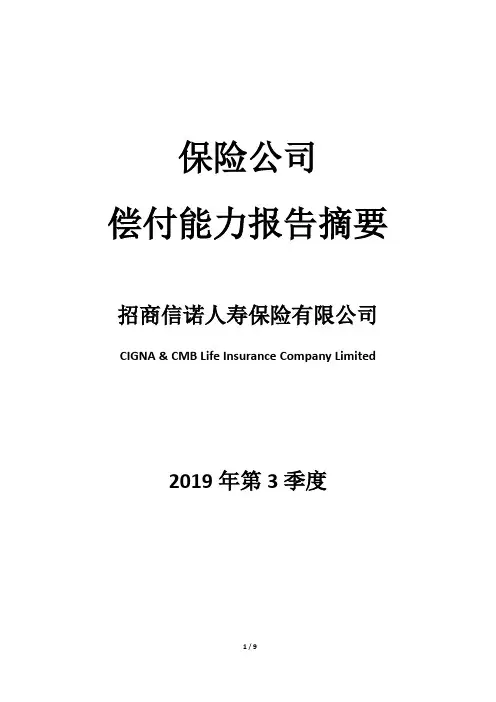
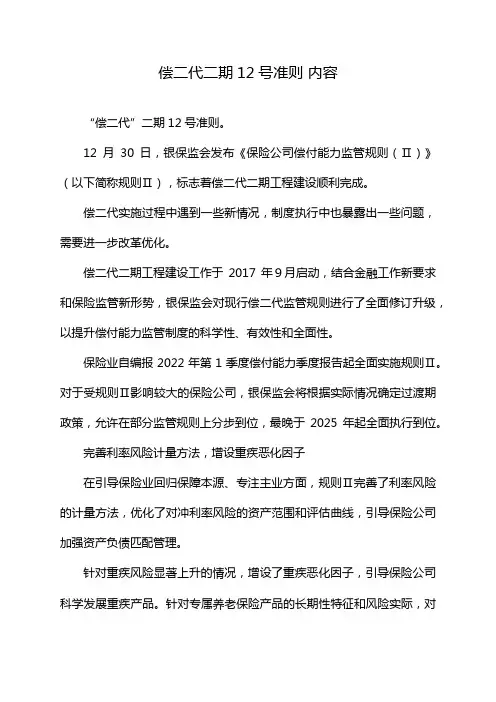
偿二代二期12号准则内容“偿二代”二期12号准则。
12月30日,银保监会发布《保险公司偿付能力监管规则(Ⅱ)》(以下简称规则Ⅱ),标志着偿二代二期工程建设顺利完成。
偿二代实施过程中遇到一些新情况,制度执行中也暴露出一些问题,需要进一步改革优化。
偿二代二期工程建设工作于2017年9月启动,结合金融工作新要求和保险监管新形势,银保监会对现行偿二代监管规则进行了全面修订升级,以提升偿付能力监管制度的科学性、有效性和全面性。
保险业自编报2022年第1季度偿付能力季度报告起全面实施规则Ⅱ。
对于受规则Ⅱ影响较大的保险公司,银保监会将根据实际情况确定过渡期政策,允许在部分监管规则上分步到位,最晚于2025年起全面执行到位。
完善利率风险计量方法,增设重疾恶化因子在引导保险业回归保障本源、专注主业方面,规则Ⅱ完善了利率风险的计量方法,优化了对冲利率风险的资产范围和评估曲线,引导保险公司加强资产负债匹配管理。
针对重疾风险显著上升的情况,增设了重疾恶化因子,引导保险公司科学发展重疾产品。
针对专属养老保险产品的长期性特征和风险实际,对长寿风险最低资本给予10%的折扣,以体现监管支持导向。
不得将投资性房地产的评估增值计入实际资本在促进保险业增强服务实体经济质效方面,规则Ⅱ完善了长期股权投资的实际资本和最低资本计量标准,大幅提升了风险因子,对具有控制权的长期股权投资(子公司),实施资本100%全额扣除,促使保险公司专注主业,防止资本在金融领域野蛮生长。
规定保险公司不得将投资性房地产的评估增值计入实际资本,引导保险资金更大力度支持实体经济。
《保险公司偿付能力监管规则第1号:实际资本》第十三条关于投资性房地产统一按成本模式计量金额作为其认可价值的规定,在新旧规则切换日的规定如下:对于以公允价值模式计量的投资性房地产,保险公司以2022年1月1日作为初始计量日,将其账面价值作为初始成本,按成本模式计量其认可价值。
其中,投资性房地产的购置成本作为核心一级资本,评估增值作为附属一级资本。
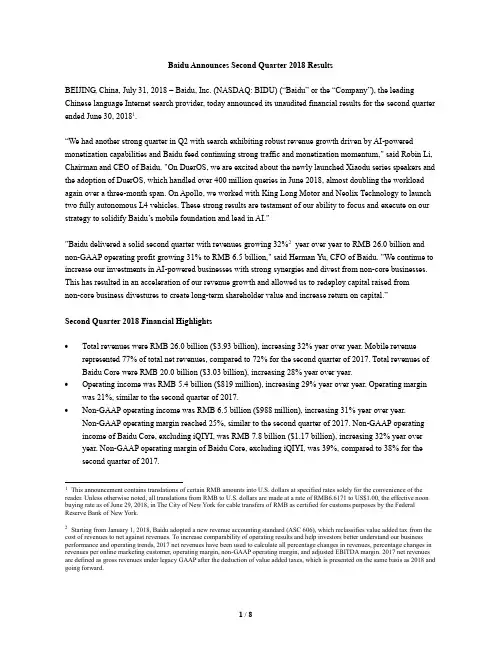
Baidu Announces Second Quarter 2018 ResultsBEIJING, China, July 31, 2018 –Baidu, Inc. (NASDAQ: BIDU) (“Baidu” or the “Company”), the leading Chinese language Internet search provider, today announced its unaudited financial results for the second quarter ended June 30, 20181.“We had another strong quarter in Q2 with search exhibiting robust revenue growth driven by AI-powered monetization capabilities and Baidu feed continuing strong traffic and monetization momentum," said Robin Li, Chairman and CEO of Baidu. "On DuerOS, we are excited about the newly launched Xiaodu series speakers and the adoption of DuerOS, which handled over 400 million queries in June 2018, almost doubling the workload again over a three-month span. On Apollo, we worked with King Long Motor and Neolix Technology to launch two fully autonomous L4 vehicles. These strong results are testament of our ability to focus and execute on our strategy to solidify Baidu’s mobile foundation and lead in AI.""Baidu delivered a solid second quarter with revenues growing 32%2year over year to RMB 26.0 billion and non-GAAP operating profit growing 31% to RMB 6.5 billion," said Herman Yu, CFO of Baidu. "We continue to increase our investments in AI-powered businesses with strong synergies and divest from non-core businesses. This has resulted in an acceleration of our revenue growth and allowed us to redeploy capital raised fromnon-core business divestures to create long-term shareholder value and increase return on capital.”Second Quarter 2018 Financial Highlights∙Total revenues were RMB 26.0 billion ($3.93 billion), increasing 32% year over year. Mobile revenue represented 77% of total net revenues, compared to 72% for the second quarter of 2017. Total revenues of Baidu Core were RMB 20.0 billion ($3.03 billion), increasing 28% year over year.∙Operating income was RMB 5.4 billion ($819 million), increasing 29% year over year. Operating margin was 21%, similar to the second quarter of 2017.∙Non-GAAP operating income was RMB 6.5 billion ($988 million), increasing 31% year over year.Non-GAAP operating margin reached 25%, similar to the second quarter of 2017. Non-GAAP operating income of Baidu Core, excluding iQIYI, was RMB 7.8 billion ($1.17 billion), increasing 32% year over year. Non-GAAP operating margin of Baidu Core, excluding iQIYI, was 39%, compared to 38% for the second quarter of 2017.1This announcement contains translations of certain RMB amounts into U.S. dollars at specified rates solely for the convenience of the reader. Unless otherwise noted, all translations from RMB to U.S. dollars are made at a rate of RMB6.6171 to US$1.00, the effective noon buying rate as of June 29, 2018, in The City of New York for cable transfers of RMB as certified for customs purposes by the Federal Reserve Bank of New York.2Starting from January 1, 2018, Baidu adopted a new revenue accounting standard (ASC 606), which reclassifies value added tax from the cost of revenues to net against revenues. To increase comparability of operating results and help investors better understand our business performance and operating trends, 2017 net revenues have been used to calculate all percentage changes in revenues, percentage changes in revenues per online marketing customer, operating margin, non-GAAP operating margin, and adjusted EBITDA margin. 2017 net revenues are defined as gross revenues under legacy GAAP after the deduction of value added taxes, which is presented on the same basis as 2018 and going forward.∙Net income attributable to Baidu was RMB 6.4 billion ($967 million), and diluted earnings attributable to Baidu per ADS was RMB 18 ($2.74). Non-GAAP net income attributable to Baidu3was RMB 7.4 billion ($1.12 billion) and non-GAAP diluted earnings per ADS4was RMB 21 ($3.18).∙Adjusted EBITDA was RMB 7.4 billion ($1.12 billion), or 29% of total revenues.Other HighlightsCorporate∙At Baidu Create, Baidu’s AI developer conference, which was attended by over 7,300 developers and partners from around the world earlier this month in Beijing, Baidu announced the release of Baidu Brain v3.0 and a host of other releases, as well as plans to develop Kunlun, a high performance AI chip for cloud to edge scenarios, including data centers, public clouds and autonomous vehicles.∙Baidu and China Mobile formed a strategic partnership to cooperate in AI, big data and 5G, and agreed to jointly explore opportunities in autonomous driving and Internet of Things (IoT) at home.∙Forbes magazine named Baidu as one of the “50 Most Innovative Companies,” recognizing Baidu’s DuerOS and Apollo AI open platforms for their leadership and innovation in conversational AI andautonomous driving in its China edition. iQIYI was also recognized for its leadership and innovation in online entertainment in China.∙Baidu announced a $1 billion share repurchase program (“2018 Share Repurchase Program”) in June 2018, which is effective for 12 months. From the announcement of the program to date, the Company has given back to its shareholders approximately $186.8 million under the 2018 Share Repurchase Program.Search and Feed∙Baidu App, which offers search and personalized news feed, continues to see robust growth, reaching 148 million daily active users in June 2018, up 17% from the same period last year.∙At Baidu Create, Baidu announced the launch of its smart mini program, which allows mobile apps in the form of a mini program to directly provide users with a seamless native-app experience through the Baidu App and other major apps in its network, bypassing the additional step of an app download.∙People's Daily, a major state-owned news platform in China, joined Baijiahao (“BJH”), Baidu feed’s c ontent network, contributing over 2,000 media sources, representing approximately 38,000 BJH accounts.∙Baidu upgraded its AI-powered ad monitoring system, which can now remove bad ads at a rate of up to 4,500 ads per minute.∙Baidu received the 2018 Entrepreneurship, Creativity & Innovation Award, which recognized Coca Cola’s augmented reality marketing campaign on Baidu for its creative integration of data, technology andmarketing.3Non-GAAP net income attributable to Baidu represents net income attributable to Baidu excluding share-based compensation expenses, the gain or loss associated with the issuance of the shares by our equity method investees at a price higher or lower than our carrying value per share, disposal gain or loss, impairment of long-term investments and fair value change of long-term investments, as adjusted for the tax effects on non-GAAP adjustments.4Non-GAAP diluted earnings per ADS represents diluted earnings per ADS calculated based on non-GAAP net income attributable to Baidu.DuerOS∙Baidu released DuerOS v3.0, which features an improved interactive user experience, enriched content ecosystem and upgraded turn-key solutions for the DuerOS Intelligent Device Platform. DuerOS v3.0 supports new capabilities, including voiceprint recognition, children mode, continuous conversation without wake words (“Geek Mode”), video recognition and more, and added new content partners, includingDiscovery, VIPKID online education and Kaishu Storytelling.∙DuerOS installed base reached 90 million devices and voice queries surpassed 400 million in June 2018.∙In June 2018, Baidu launched DuerOS-powered Xiaodu Smart Speaker, which sold out 10,000 units within90 seconds of its first two online sales, continuing its popular Xiaodu series speaker.∙DuerOS entered the hospitality industry with Xiaodu Smart Speakers by partnering with InterContinental Hotels Group (IHG) to bring about AI smart hotel rooms into China, which allow customers to control their room and ask for hotel information using Baidu’s conversational AI.∙Baidu formed strategic cooperation with over 20 global and domestic auto OEMs, including the BMW Group, Daimler AG, Ford Motor, Hyundai, KIA, Chery, BAIC, the FAW Group and Byton, to provide DuerOS for auto solutions, encompassing entertainment, internet services and safety features, using Baidu’s conversational AI, facial recognition, augmented reality navigation and other AI capabilities.Apollo∙King Long Motor launched Apolong, China’s first fully autonomous L4 minibus, powered by Apollo.V olume production of 100 units was reached on July 4, 2018.∙Neolix Technology launched an L4 micro-car for cargo delivery powered by Apollo, Baidu’s autonomous driving platform.∙Baidu released Apollo v3.0, which supports volume production for L4 minibuses (fully autonomous shuttle buses without steering wheel) and L4 microcars (fully autonomous goods delivery vehicles), addsautonomous L3 valet parking, and significantly shortens autonomous vehicle development lead time.∙Apollo has garnered 119 OEM, Tier 1 parts supplier and other partners, adding recently Jaguar Land Rover, Byton, Valeo, ADI, Flextronics, Suning, Lionbridge and others.∙Baidu signed a memorandum of understanding with Daimler AG to expand the companies’ partnership through the Apollo autonomous driving platform and integrate Baidu’s vehicle connectivity servi ces into Mercedes-Benz’s infotainment system MBUX. In July 2018, Daimler became the first global OEM t o receive an autonomous driving license in Beijing using a vehicle powered by Apollo L4 technology.∙Baidu formed a partnership with BMW Group to develop vehicle connectivity services and collaborate on autonomous driving and smart transport. BMW Group has also joined Apollo as a board member.∙Baidu released the Apollo Pilot Safety Report, China's first safety report on autonomous driving for volume production, which serves to help define the safety framework for the industry.AI Technology∙Baidu released Baidu Brain v3.0, which features multi-modal deep semantic understanding to enable world-class conversational AI in Chinese, along with a full stack of over 110 AI capabilities. At Baidu Create, Baidu also released three advanced, easy-to-use tool kits—EasyDL, AutoDL and AI Studio—for developers to work with PaddlePaddle to build and train deep learning models at scale. PaddlePaddle isBaidu’s open-sourced deep learning platform made available to developers and businesses to implement their AI ideas.Baidu received top awards from prestigious AI competitions, including 2018 WebVision Challenge (image recognition competition) and 2018 ActivityNet Challenge (video recognition competition).Second Quarter 2018 ResultsTotal revenues reached RMB 26.0 billion ($3.93 billion), representing a 32% increase year over year.Online marketing revenues were RMB 21.1 billion ($3.18 billion), representing a 25% increase year over year. Baidu had approximately 511,000 active online marketing customers5, representing a 9% increase year over year. Revenue per online marketing customer was approximately RMB 41,200 ($6,200), a 16% increase year over year.Other revenues reached RMB 4.9 billion ($742 million), representing a 75% year over year, which was mainly due to the robust growth in iQIYI membership and other businesses.Revenue from Baidu Core6reached RMB 20.0 billion ($3.03 billion), up 28% year over year, while revenue from iQIYI reached RMB 6.2 billion ($932 million), up 51% year over year.Content costs were RMB 5.2 billion ($788 million), representing a 68% increase year over year. Theyear-over-year increase was mainly due to iQIYI’s increased content cos ts and, to a lesser extent, increased investment in BJH, Baidu feeds’ content network.Traffic acquisition cost was RMB 2.7 billion ($408 million), representing a 9% increase year over year.Bandwidth costs were RMB 1.6 billion ($234 million), representing a 12% increase year over year.Other cost of revenues, which include depreciation costs, operation costs, sales tax and surcharges andshare-based compensation expenses, was RMB 2.6 billion ($386 million), increasing 5% year over year.Selling, general and administrative expenses were RMB 4.5 billion ($681 million), increasing 54% year over year, primarily due to the increase in channel and promotional marketing.Research and development expenses were RMB 4.0 billion ($609 million), increasing 28% year over year, primarily due to the growth of personnel-related costs.5The number of active online marketing customers and revenue per online active customer exclude our group-buying and delivery related businesses for consistency with previous reporting.6Since the beginning of 2017, we have disposed of or planned to disclose certain non-core businesses including Baidu Mobile Games, Baidu Deliveries, Global DU businesses, and Du Xiaoman (our financial services business). Those businesses generated approximatelyRMB 1.0 billion revenues and 0.1 billion operating profit, excluding share-based compensation expenses, for the second quarter of 2018. We expect these divestures together will generate approximately US$1.8 billion in cash.Operating income was RMB 5.4 billion ($819 million), increasing 29% year over year. Non-GAAP operating income was RMB 6.5 billion ($988 million), increasing 31% year over year. Operating income from Baidu Core was RMB 6.7 billion ($1.02 billion), increasing 31% year over year. Non-GAAP operating income from Baidu Core was RMB 7.8 billion ($1.17 billion), increasing 32% year over year.Income tax expense was RMB 1.1 billion ($164 million), compared to RMB 564 million in the second quarter of 2017. Effective tax rate was 18%, compared to 11% for the second quarter of 2017, which benefited from the disposal of certain subsidiaries.Net loss attributable to noncontrolling interests was RMB 1.3 billion ($201 million), which included the loss related to the conversion of noncontrolling preferred shares to ordinary shares upon iQIYI’s IPO and the loss on investment arising from a change in fair market value per ASC 321.Net income attributable to Baidu was RMB 6.4 billion ($967 million), increasing 45% year over year. Diluted earnings per ADS amounted to RMB 18 ($2.74). Non-GAAP net income attributable to Baidu was RMB 7.4 billion ($1.12 billion), increasing 57% year over year. Non-GAAP diluted earnings per ADS amounted to RMB 21 ($3.18).Adjusted EBITDA reached RMB 7.4 billion ($1.12 billion) and adjusted EBITDA margin reached 29%. Adjusted EBITDA for Baidu Core reached RMB 8.6 billion ($1.29 billion) and adjusted EBITDA margin reached 43%.As of June 30, 2018, cash, cash equivalents, restricted cash and short-term investments were RMB 128.3 billion ($19.38 billion). Net cash generated from operating activities was RMB 7.1 billion ($1.08 billion) and capital expenditures were RMB 1.5 billion ($227 million). Excluding iQIYI, cash, cash equivalents, restricted cash and short-term investments were RMB 115.2 billion ($17.41 billion), as of June 30, 2018. Excluding iQIYI, net cash generated from operating activities was RMB 7.0 billion ($1.05 billion), and capital expenditures were RMB 1.3 billion ($202 million).In April 2018, Baidu entered into definitive agreements to divest Du Xiaoman, our financial services business. Assets of RMB 38.1 billion ($5.76 billion) and liabilities of RMB 27.3 billion ($4.13 billion) associated with Du Xiaoman were reclassified to assets and liabilities held for sale on the condensed consolidated balance sheet as of June 30, 2018. The transactions contemplated under the definitive agreements are subject to certain closing conditions and are currently expected to close in the second half of 2018.Financial GuidanceFor the third quarter of 2018, Baidu expects revenues to be between RMB 27.37 billion ($4.02 billion7) and RMB 28.77 billion ($4.23 billion), representing a 23% to 30% increase year over year. Excluding the impact from announced divestures, including Global DU and Du Xiaoman, Baidu expects revenues to be between RMB 26.56 billion ($3.91 billion) and RMB 27.92 billion ($4.11 billion), representing a 26% to 33% increase year over year. This forecast reflects Baidu’s current and preliminary view, which is subject to substantial uncertainty.Conference Call InformationBaidu's management will hold an earnings conference call at 9:15 PM on July 31, 2018, U.S. Eastern Time (9:15 AM on August 1, 2018, Beijing/Hong Kong Time). Dial-in details for the earnings conference call are as follows:International: +65 67135090China 4006208038US: +1 8456750437UK: +44 2036214779Hong Kong:+852 ********Passcode for all regions:3485259A replay of the conference call may be accessed by phone at the following number until August 8, 2018: International: +61 2 8199 0299Passcode: 3485259Additionally, a live and archived webcast of this conference call will be available at .About BaiduBaidu, Inc. is the leading Chinese language Internet search provider. Baidu aims to make a complex world simpler through technology. Baidu’s ADSs trade on the NASDAQ Global Select M arket under the symbol “BIDU.” Currently, ten ADSs represent one Class A ordinary share.Contacts7The translations from RMB to U.S. dollars for the expected revenues in the third quarter of 2018 are made at a rate of RMB6.80 to US$1.0, the rounded noon buying rate as of July 20, 2018, in The City of New York for cable transfers of RMB as certified for customs purposes by the Federal Reserve Bank of New York.Investors Relations, Baidu, Inc.Tel: +86-10-5992-4958Email: ir@Safe Harbor StatementThis announcement contains forward-looking statements. These statements are made under the "safe harbor" provisions of the U.S. Private Securities Litigation Reform Act of 1995. These forward-looking statements can be identified by terminology such as "will," "expects," "anticipates," "future," "intends," "plans," "believes," "estimates," "confident" and similar statements. Among other things, the outlook for the third quarter of 2018, quotations from management in this announcement, as well as Baidu's and other parties' strategic and operational plans, contain forward-looking statements. Baidu may also make written or oral forward-looking statements in its periodic reports to the U.S. Securities and Exchange Commission, in its annual report to shareholders, in press releases and other written materials and in oral statements made by its officers, directorsor employees to third parties. Statements that are not historical facts, including but not limited to statements about Baidu's beliefs and expectations, are forward-looking statements. Forward-looking statements involve inherent risks and uncertainties. A number of factors could cause actual results to differ materially from those contained in any forward-looking statement, including but not limited to the following: Baidu’s growth strategies; its future business development, including development of new products and services; its ability to attract and retain users and customers; competition in the Chinese Internet search market; competition for online marketing customers; changes in the Company’s revenues and c ertain cost or expense items as a percentage of its revenues; the outcome of ongoing, or any future, litigation or arbitration, including those relating to intellectual property rights; the expected growth of the Chinese language Internet search market and the number of Internet and broadband users in China; Chinese governmental policies relating to the Internet and Internet search providers and general economic conditions in China, Japan and elsewhere. Further information regarding these and other risks is included in the Company’s annual report on Form 20-F and other documents filed with the Securities and Exchange Commission. Baidu does not undertake any obligation to update any forward-looking statement, except as required under applicable law. All information provided in this press release and in the attachments is as of the date of the press release, and Baidu undertakes no duty to update such information, except as required under applicable law.Non-GAAP Financial MeasuresTo supplement Baidu’s conso lidated financial results presented in accordance with GAAP, Baidu uses the following non-GAAP financial measures: non-GAAP operating income/loss, non-GAAP operating margin,non-GAAP net income attributable to Baidu, non-GAAP diluted earnings per ADS, adjusted EBITDA and adjusted EBITDA margin. The presentation of these non-GAAP financial measures is not intended to be considered in isolation or as a substitute for the financial information prepared and presented in accordance with GAAP.Baidu believes that these non-GAAP financial measures provide meaningful supplemental information regardingits performance and liquidity by excluding certain items that may not be indicative of its recurring core business operating results, such as operating performance excluding not only non-cash charges, but also other items that are infrequent or unusual in nature. The Company believes that both management and investors benefit from referring to these non-GAAP financial measures in assessing its performance and when planning and forecasting future periods. These non-GAAP financial measures also facilitate management’s internal comparisons to Baidu’s historical performance and liquidity. The Company believes these non-GAAP financial measures are useful to investors in allowing for greater transparency with respect to supplemental information used by management in its financial and operational decision making. A limitation of using these non-GAAP financial measures is that these non-GAAP measures exclude certain items that have been and will continue to be for the foreseeable future a significant component in the Company’s results of operations.These non-GAAP financial measures presented here may not be comparable to similarly titled measures presented by other companies. Other companies may calculate similarly titled measures differently, limiting their usefulness as comparative measures to the Company’s data.Non-GAAP operating income represents operating income excluding share-based compensation expenses.Non-GAAP net income attributable to Baidu represents net income attributable to Baidu excluding share-based compensation expenses, the gain or loss associated with the issuance of shares by Baidu’s equity method investees at a price higher or lower than the carrying value per share, disposal gain or loss, impairment oflong-term investments, fair value change of long-term investments, as adjusted for related income tax effects. Non-GAAP diluted earnings per ADS represents diluted earnings per ADS calculated based on non-GAAP net income attributable to Baidu. Adjusted EBITDA represents operating income excluding depreciation, amortization (excluding the amortization of licensed copyrights and produced content of iQIYI) and share-based compensation expenses.For more information on non-GAAP financial measures, please see the tables captioned “Reconciliations of non-GAAP financial measures to the nearest comparable GAAP measures.”Baidu, Inc.Condensed Consolidated Statements of IncomeThree Months EndedJune 30, March 31, June 30, (In RMB millions except for share, per share (or ADS) information) 2017 2018 2018Unaudited Unaudited Unaudited Revenues:Online marketing services 17,883 17,169 21,065 Others 2,991 3,738 4,907 Total revenues(note 1) 20,874 20,907 25,972Operating costs and expenses:Content costs 3,112 4,194 5,213 Traffic acquisition costs 2,478 2,256 2,698 Bandwidth costs 1,382 1,472 1,550 Others 3,610 1,981 2,551 Cost of revenues (note 2) 10,582 9,903 12,012 Selling, general and administrative (note 2) 2,934 3,142 4,505 Research and development (note 2) 3,148 3,294 4,033 Total operating costs and expenses 16,664 16,339 20,550Operating income 4,210 4,568 5,422Other income:Interest income 712 821 882 Interest expense (334 )(352 )(478 ) Foreign exchange income(loss), net (139 )(48 )30 Income(loss) from equity method investments (118 )(177 )69 Other income, net 643 1,856 231 Total other income 764 2,100 734 Income before income taxes 4,974 6,668 6,156 Income taxes 564 1,120 1,086 Net income 4,410 5,548 5,070 Less: net loss attributable to noncontrolling interests (5 )(1,146 )(1,332 ) Net income attributable to Baidu 4,415 6,694 6,402Earnings per share for Class A and Class B ordinary shares:-Basic 113.58 188.60 183.16 -Diluted 113.11 186.76 181.36 Earnings per ADS (1 Class A ordinary share equals 10 ADSs ):-Basic 11.36 18.86 18.32 -Diluted 11.31 18.68 18.14 Weighted average number of Class A and Class B ordinary sharesoutstanding:Basic 34,678,268 34,838,392 34,953,564 Diluted 34,824,387 35,180,950 35,299,428(1)Starting on January 1, 2018, valued added tax has been reclassified from cost of revenues to net against revenues. To increasecomparability of operating results and help investors better understand our business performance and trends, 2017 net revenues have been presented. 2017 net revenues are defined as gross revenues under legacy GAAP after the deduction of value added taxes, which is presented on the same basis as 2018 and going forward.Three Months EndedJune 30, March 31, June 30,2017 2018 2018Unaudited Unaudited Unaudited Gross revenues 20,874 22,162 27,520 Less: value added taxes 1,175 1,255 1,548 Net revenues 19,699 20,907 25,972(2) Includes share-based compensation expenses as follows:Cost of revenues 48 35 60 Selling, general and administrative 236 291 302 Research and development 512 452 755 Total share-based compensation expenses 796 778 1,117Baidu, Inc.Condensed Consolidated Balance SheetsDecember 31, June 30, (In RMB millions except for number of shares and per share data) 2017 2018Audited Unaudited ASSETSCurrent assets:Cash and cash equivalents 11,084 28,859 Restricted cash 252 681 Short-term investments 89,381 98,725 Other invested securities 18,350 - Accounts receivable, net 4,571 4,863 Loans and interest receivable, net 23,938 - Amounts due from related parties 168 785 Other assets, current 3,425 5,948 Assets held for sale - 38,113 Total current assets 151,169 177,974 Non-current assets:Fixed assets, net 12,475 14,647 Intangible assets, net 5,467 6,875 Goodwill 15,806 15,806 Long-term investments, net 56,283 63,123 Loans and interest receivable, net 3,467 - Amounts due from related parties 9 115 Deferred tax assets, net 1,532 1,338 Other assets, non-current 5,520 8,442 Total non-current assets 100,559 110,346 Total assets 251,728 288,320LIABILITIES AND EQUITYCurrent liabilities:Short-term loans 1,244 633 Amounts due to the third-party investors 38,486 - Accounts payable and accrued liabilities 27,523 30,648 Customer advances and deposits 6,785 6,914 Deferred revenue 788 1,386 Deferred income 568 542 Long-term loans, current portion 10 10 Notes payable, current portion 6,500 13,220 Amounts due to related parties 153 538 Liabilities held for sale - 27,311 Total current liabilities 82,057 81,202 Non-current liabilities:Deferred income 73 49 Deferred revenue - 1,499 Long-term loans 6,701 7,534 Notes payable 29,111 32,892 Deferred tax liabilities 3,375 3,382 Other non-current liabilities 39 74 Total non-current liabilities 39,299 45,430 Total liabilities 121,356 126,632December 31, June 30, (In RMB millions except for number of shares and per share data) 2017 2018Audited Unaudited Redeemable noncontrolling interests 11,022 - EquityClass A Ordinary Shares, par value US$0.00005 per share, 825,000,000shares authorized, and 27,614,978 shares and 27,809,471 shares issuedand outstanding as at December 31, 2017 and June 30, 2018 - - Class B Ordinary Shares, par value US$0.00005 per share, 35,400,000shares authorized, and 7,201,254 shares and 7,201,254 shares issued andoutstanding as at December 31, 2017 and June 30, 2018 - - Additional paid-in capital 12,088 30,663 Retained earnings 102,328 118,113 Accumulated other comprehensive income 930 304 Total Baidu, Inc. shareholders’ equity115,346 149,080 Noncontrolling interests 4,004 12,608 Total equity 119,350 161,688 Total liabilities, redeemable noncontrolling interests, and equity 251,728 288,320。
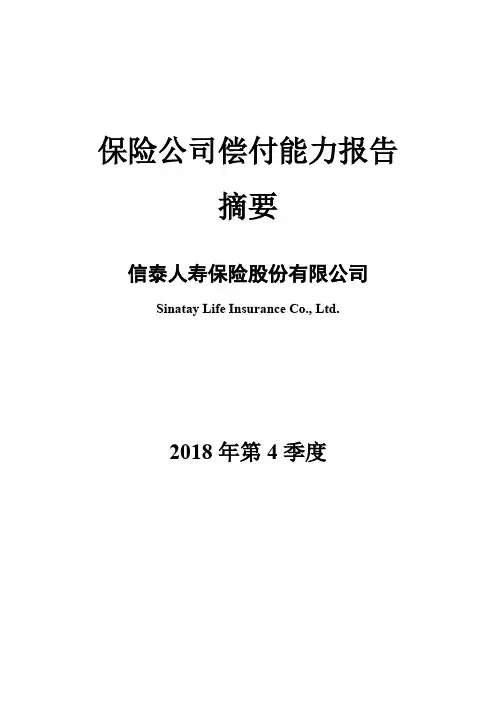
保险公司偿付能力报告摘要信泰人寿保险股份有限公司Sinatay Life Insurance Co., Ltd.2018年第4季度公司信息公司名称(中文):信泰人寿保险股份有限公司公司名称(英文):Sinatay Life Insurance Co., Ltd.法定代表人:邹平笙注册地址:中国浙江省杭州市江干区五星路66号19层、20层、21层、22层、24层(电梯层21层、22层、23层、24层、26层)业务范围:人寿保险、健康保险、意外伤害保险等各类人身保险业务;上述业务的再保险业务;国家法律、法规允许的保险资金运用业务;经原中国保监会批准的其他业务经营区域:浙江、江苏、北京、河北、福建、河南、山东、黑龙江、辽宁、宁波、上海、湖北、江西、厦门、广东、青岛、深圳、大连报告联系人:谢评联系电话:010-********目录一、基本信息 (1)二、主要指标 (5)三、实际资本 (6)四、最低资本 (7)五、风险综合评级 (8)六、风险管理状况 (8)七、流动性风险 (9)八、监管机构对公司采取的监管措施 (10)一、基本信息(一)股权结构及股东1.股权结构单位:万股股权类别股份或出资额占比(%)国家股- - 社团法人股500,000.00 100.00 外资股- - 自然人股- - 其他- - 合计500,000.00 100.002.股东持股情况单位:万股股东名称股份类别数量状态浙江永利实业集团有限公司社团法人股235,619.05部分被质押北京九盛资产管理有限责任公司社团法人股990,00.00部分被质押浙江华升物流有限公司社团法人股74,500.00部分被质押利时集团控股有限公司社团法人股36,900.00 正常连云港同华文化发展有限公司社团法人股12,502.00被冻结升华集团控股有限公司社团法人股10,838.00 正常电联控股集团有限公司社团法人股9,608.00 正常连云港市宾逸建设工程有限公司社团法人股7,360.00 被冻结浙江建艺装饰有限公司社团法人股8,001.95 被冻结三门金石园林有限公司社团法人股4,700.00 被冻结杭州冠重铸机有限公司社团法人股971.00 正常合计——500,000.00 ——(二)实际控制人无。

2018-保险公司偿付能力管理规定-实用word文档
本文部分内容来自网络,本司不为其真实性负责,如有异议或侵权请及时联系,本司将予以删除!
== 本文为word格式,下载后可随意编辑修改! ==
保险公司偿付能力管理规定
保险公司偿付能力管理规定
(中国保险监督管理委员会令201X年第1号)
《保险公司偿付能力管理规定》已经201X年6月30日中国保险监督管理委员会主席办公会审议通过,现予公布,自201X年9月1日起施行。
主席吴定富
二○○八年七月十日
保险公司偿付能力管理规定
第一章总则
第一条为了加强保险公司偿付能力监管,维护被保险人利益,促进保险业健康、稳定、持续发展,根据《中华人民共和国保险法》,制定本规定。
第二条本规定所称保险公司,是指依法设立的经营商业保险业务的保险公司和外国保险公司分公司。
本规定所称保险公司偿付能力是指保险公司偿还债务的能力。
第三条保险公司应当具有与其风险和业务规模相适应的资本,确保偿付能力充足率不低于100%。
偿付能力充足率即资本充足率,是指保险公司的实际资本与最低资本的比率。
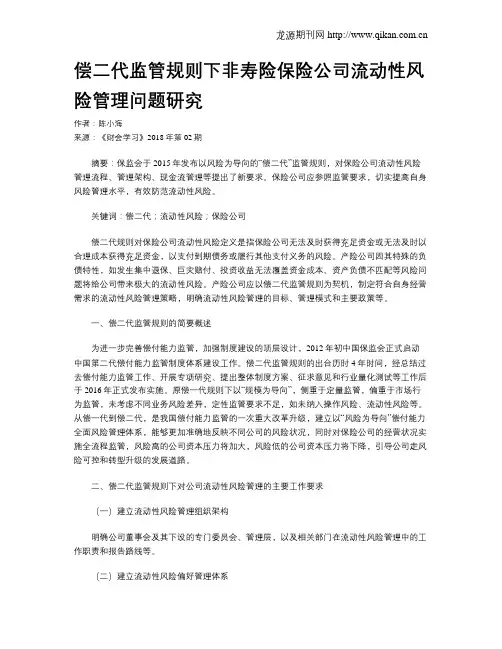
偿二代监管规则下非寿险保险公司流动性风险管理问题研究作者:陈小海来源:《财会学习》2018年第02期摘要:保监会于2015年发布以风险为导向的“偿二代”监管规则,对保险公司流动性风险管理流程、管理架构、现金流管理等提出了新要求。
保险公司应参照监管要求,切实提高自身风险管理水平,有效防范流动性风险。
关键词:偿二代;流动性风险;保险公司偿二代规则对保险公司流动性风险定义是指保险公司无法及时获得充足资金或无法及时以合理成本获得充足资金,以支付到期债务或履行其他支付义务的风险。
产险公司因其特殊的负债特性,如发生集中退保、巨灾赔付、投资收益无法覆盖资金成本、资产负债不匹配等风险问题将给公司带来极大的流动性风险。
产险公司应以偿二代监管规则为契机,制定符合自身经营需求的流动性风险管理策略,明确流动性风险管理的目标、管理模式和主要政策等。
一、偿二代监管规则的简要概述为进一步完善偿付能力监管,加强制度建设的顶层设计,2012年初中国保监会正式启动中国第二代偿付能力监管制度体系建设工作。
偿二代监管规则的出台历时4年时间,经总结过去偿付能力监管工作、开展专项研究、提出整体制度方案、征求意见和行业量化测试等工作后于2016年正式发布实施。
原偿一代规则下以“规模为导向”,侧重于定量监管,偏重于市场行为监管,未考虑不同业务风险差异,定性监管要求不足,如未纳入操作风险、流动性风险等。
从偿一代到偿二代,是我国偿付能力监管的一次重大改革升级,建立以“风险为导向”偿付能力全面风险管理体系,能够更加准确地反映不同公司的风险状况,同时对保险公司的经营状况实施全流程监管,风险高的公司资本压力将加大,风险低的公司资本压力将下降,引导公司走风险可控和转型升级的发展道路。
二、偿二代监管规则下对公司流动性风险管理的主要工作要求(一)建立流动性风险管理组织架构明确公司董事会及其下设的专门委员会、管理层,以及相关部门在流动性风险管理中的工作职责和报告路线等。
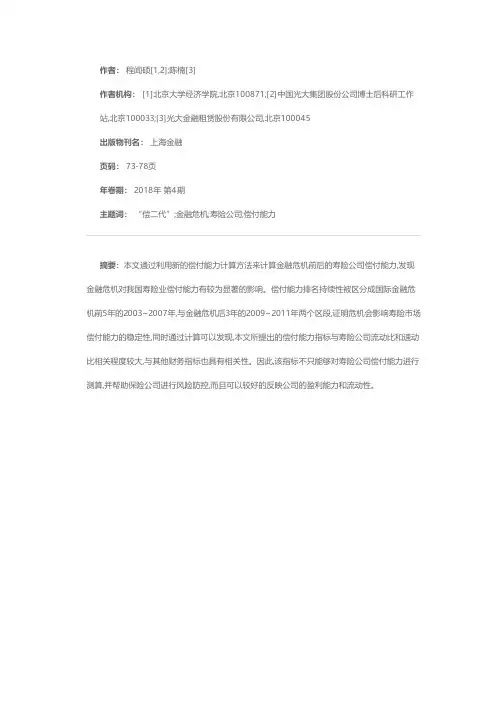
作者: 程闻硕[1,2];陈楠[3]
作者机构: [1]北京大学经济学院,北京100871;[2]中国光大集团股份公司博士后科研工作站,北京100033;[3]光大金融租赁股份有限公司,北京100045
出版物刊名: 上海金融
页码: 73-78页
年卷期: 2018年 第4期
主题词: “偿二代”;金融危机;寿险公司;偿付能力
摘要:本文通过利用新的偿付能力计算方法来计算金融危机前后的寿险公司偿付能力,发现金融危机对我国寿险业偿付能力有较为显著的影响。
偿付能力排名持续性被区分成国际金融危机前5年的2003~2007年,与金融危机后3年的2009~2011年两个区段,证明危机会影响寿险市场偿付能力的稳定性,同时通过计算可以发现,本文所提出的偿付能力指标与寿险公司流动比和速动比相关程度较大,与其他财务指标也具有相关性。
因此,该指标不只能够对寿险公司偿付能力进行测算,并帮助保险公司进行风险防控,而且可以较好的反映公司的盈利能力和流动性。

2023年初级银行从业资格之初级公司信贷考试题库单选题(共40题)1、下列不属于贷款审查事项的是()。
A.信贷资料完整性及调查工作与申报流程的合规性审查B.借款人主体资格及基本情况审查C.信贷业务政策符合性审查D.逾期贷款催收措施的制定【答案】 D2、下列不属于贷前调查的主要对象的是()。
A.担保人B.借款人的开户行C.抵(质)押人D.借款人【答案】 B3、下列关于还款账户的表述,错误的是()。
A.对于固定资产贷款,一般而言,当借款人信用状况较好、贷款安全系数较高时,银行业金融机构可不要求借款人开立专门的还款准备金账户B.对于项目融资业务,贷款人应要求借款人指定专门的项目收入账户,并约定所有项目的资金收入均须进入此账户C.“专门账户”是指《人民币结算账户管理办法》中的“专用账户”D.对于流动资金贷款,贷款人必须指定或设立专门资金回笼账户【答案】 C4、(2018年真题)下列不属于借款需求主要影响因素的是()。
A.额外的或非预期性支出B.资产使用效率下降C.固定资产重置及扩张D.股权结构变动【答案】 D5、(2016年真题)下列不可以作为保证人的是()。
A.经商业银行认可的企业法人的职能部门B.经商业银行认可的具有较强代为清偿能力的、无重大债权债务纠纷的金融机构C.经商业银行认可的具有较强代为清偿能力的、无重大债权债务纠纷的从事经营活动的事业法人D.经商业银行认可的具有较强代为清偿能力的、无重大债权债务纠纷的自然人【答案】 A6、(2021年真题)商业银行总行每年应对全行集团客户授信风险作()次综合评估,同时应当检查分支机构对相关制度的执行情况,对违反规定的行为应当严肃查处。
商业银行每年应至少向银行业监督管理机构提交()次相关风险评估报告。
A.2:2B.1;2C.1;1D.2;1【答案】 C7、(2017年真题)商业银行对抵债资产的账实核对频率至少应为()一次。
A.每月B.每半年C.每旬D.每季度【答案】 D8、下列关于借款人权利的说法,错误的是()。
2018年度基于偿二代体系的sarmra评估结果1. 引言1.1 概述在现代社会中,随着科技的快速发展与应用的广泛推广,电子商务、移动支付、云计算等新兴领域正日益成为人们生活中不可或缺的一部分。
而这些领域所依赖的关键基础设施就是偿付系统。
偿付二代体系作为一种较新的金融体系,在近年来取得了显著进展并成为偿付领域的主要支撑架构。
本文旨在评估基于偿二代体系的Sarmra(Systematic Analysis of Risk and Management Alignment)在2018年度的表现,并分析其结果对各行业与未来发展趋势带来的影响。
通过对Sarmra评估方法进行概述,并结合相关数据和分析指标,将全面探讨该体系在过去一年中所取得的成就和存在的问题。
1.2 文章结构本文总共分为五个章节,每个章节包含若干小节。
首先,在引言部分我们将简要介绍文章内容以及撰写目的。
接下来,第二章将从定义与特点、发展历程以及应用领域三个方面对偿二代体系进行详细阐述。
第三章将概述Sarmra评估方法,包括评估的简介、数据来源以及评估指标与分析方法。
在第四章中,将详细分析2018年度Sarmra评估结果,包括总体表现情况、关键发现与趋势以及行业差异性分析。
最后,在第五章中,我们将总结本文的主要结论,并对未来发展的展望进行建议,并探讨研究局限性及改进方向。
1.3 目的本文的主要目的有三个方面:首先,通过对偿二代体系的简介使读者了解其定义、特点、发展历程以及应用领域;其次,介绍Sarmra评估方法并阐述数据来源、评估指标与分析方法;最后,通过对2018年度Sarmra评估结果的分析和讨论,为读者提供关于该体系总体表现情况、行业趋势等重要信息,并对未来发展进行合理预测与建议。
本文旨在为相关从业人员和研究者提供参考和借鉴价值,并推动偿二代体系在金融领域取得更大进步。
2. 偿二代体系简介2.1 定义与特点偿二代体系(Second-generation Clearing System)是一种用于处理金融交易清算的先进系统。
中国人寿保险股份有限公司2018年年度报告摘要(股票代码:601628)二〇一九年三月二十七日一、重要提示1.1本年度报告摘要摘自年度报告全文,为全面了解本公司的经营成果、财务状况及未来发展规划,投资者应当到上海证券交易所网站等中国证监会指定媒体上仔细阅读年度报告全文。
1.2本公司董事会、监事会及董事、监事、高级管理人员保证年度报告内容的真实、准确、完整,不存在虚假记载、误导性陈述或重大遗漏,并承担个别和连带的法律责任。
1.3本公司第六届董事会第十二次会议于2019年3月27日审议通过《关于公司2018年年度报告(A 股/H股)的议案》,董事会会议应出席董事10人,实际出席董事8人。
董事长、执行董事王滨,执行董事苏恒轩、徐海峰,非执行董事尹兆君,独立董事张祖同、Robinson Drake Pike(白杰克)、汤欣、梁爱诗现场出席会议。
非执行董事袁长清、刘慧敏因其他公务无法出席会议,分别书面委托独立董事汤欣、非执行董事尹兆君代为出席并表决。
1.4本公司2018年度按中国企业会计准则和国际财务报告准则编制的财务报告已经安永华明会计师事务所(特殊普通合伙)和安永会计师事务所分别根据中国注册会计师审计准则和国际审计准则审计,并出具标准无保留意见的审计报告。
1.5根据2019年3月27日董事会通过的2018年度利润分配方案,按照2018年度净利润的10%提取任意盈余公积人民币12.75亿元,按已发行股份28,264,705,000股计算,拟向全体股东派发现金股利每股人民币0.16元(含税),共计约人民币45.22亿元。
上述利润分配方案尚待股东于2019年5月30日举行之年度股东大会批准后生效。
二、公司基本情况2.1 公司简介2.2 报告期公司主要业务简介本公司是中国领先的人寿保险公司,拥有由保险营销员、团险销售人员以及专业和兼业代理机构组成的广泛的分销网络,提供个人人寿保险、团体人寿保险、意外险和健康险等产品与服务。
渤海财险偿付能力之困渤海财险已连续两个季度被列为偿付能力不达标公司。
本刊记者 邢莉|文股东增资3.48亿元后,渤海财产保险股份有限公司(下称:渤海财险)偿付能力仍在低位徘徊。
日前,中国保险行业协会官网显示,渤海财险披露了二季度偿付能力报告。
报告显示,截至今年二季度末,渤海财险综合偿付能力充足率为123.75%,仅过监管100%的及格线,风险综合评级为C 级。
业绩方面,渤海财险表现同样不佳。
今年上半年,累计实现保险业务收入18.66亿元,净利润-1.48亿元。
其中,渤海财险二季度亏损超1.5亿元。
连续两季度偿付能力不达标这已是渤海财险连续两个季度风险综合评级为C 级。
此前一季度报告显示,渤海财险核心偿付能力充足率为106.62%,同比下降6.32%,偿付能力评级由B 级降到C 级。
根据监管要求,风险综合评级衡量保险公司总体偿付能力风险(包括可资本化风险和难以资本化风险)的大小,不得低于B 类。
这意味着,渤海财险已连续两个季度被列为偿付能力不达标公司。
报告同时显示,2021年4月,渤海财险收到天津银保监局下发的《金融监管警示书》,提示该公司2018年末和2019年末再保后未决赔款准备金均出现不利发展,准备金计提存在较大风险,对该公司提出监管要求,并要求渤海财险向监管部门上报分析报告与整改方案。
对此渤海财险回应称,公司成立了准备金提取不足整改领导小组,推进实施和完成监管要求的整改工作,也已经聘请了独立的精算评估机构对准备金评估结果进行审核,后续将不断优化业务结构,加强理赔管理,强化基础数据管理,提高准备金评估工作质量。
88F INANCIAL CIRCLES /金融圈·保险Copyright©博看网 . All Rights Reserved.对于连续两个季度评级为 C,渤海财险解释称,主要是由于公司偿付能力充足率在120%以下,接近100%的监管红线。
2021年二季度,渤海财险增资已到位,偿付能力充足率重新提升至120%以上。
2023二季度偿付能力明细2023年二季度偿付能力明细引言:偿付能力是保险公司衡量其经营风险的重要指标,也是评估保险公司财务健康状况的重要依据之一。
偿付能力明细是对保险公司二季度财务状况的详细分析,本篇文章将综合考虑财务报表、风险控制情况、资本充足度等多个方面,对保险公司2023年二季度的偿付能力进行明细分析。
一、资本充足度情况保险公司的资本充足度是评估其偿付能力的关键指标之一,能够反映保险公司承担风险的能力。
根据本公司2023年二季度财务报表,资本充足率为180%,高于监管要求的150%,说明本公司具备较强的经营风险抵御能力。
资本充足度的提升主要得益于公司的盈利能力增强和资本收益的稳定增长。
二、偿付能力充足率情况偿付能力充足率是衡量保险公司偿付能力的重要指标,其计算方式为保险公司的净资产与偿付能力的比率。
根据2023年二季度财务报表,偿付能力充足率为200%,高于监管要求的100%,表明保险公司能够满足客户的索赔要求,并具备充足的偿付能力。
三、资金运用情况保险公司的资金运用情况直接影响其偿付能力,合理的资金配置能够提升资金的收益和抵御风险的能力。
本公司2023年二季度资金运用情况如下:股票投资占比40%,债券投资占比30%,银行存款占比20%,其他资产占比10%。
通过合理的资金配置,保证了资产的安全性和流动性,同时也获取了较高的收益。
四、风险控制情况保险公司的风险控制能力是保障偿付能力的关键保障,有效的风险管理可以降低公司面临的风险损失。
本公司在2023年二季度加强了风险控制工作,将重点放在以下几个方面:首先,加强对保险产品风险的评估和管理,确保产品设计合理,风险可控;其次,加强对投资风险的监控和控制,建立风险预警机制;最后,完善内部审计体系,加强对业务流程的监督和管理。
五、保险责任准备金充足性保险责任准备金是保险公司为支付未决赔付和退保金等提供的一定金额的储备金,其充足性是保证保险公司偿付能力的重要指标之一。
好未来公布2018财年第二季度未经审计财务报告-季度净收入较上年同期增长68.1%-季度经营利润较上年同期增长32.6%-季度非美国会计准则经营利润较上年同期增长33.7%-季度总学生人次较上年同期增长100.6%(北京2017年10月26日消息):好未来教育(纽约证券交易所:TAL,下称“好未来”或“公司”)是中国领先的教育科技企业。
日前,公司公布其截至2017年8月31日的2018财年第二季度未经审计财务报告。
2018财年第二季度业绩摘要:-净收入从上年同期的2.711亿美元增长到本季的4.557亿美元,增幅为68.1%。
-经营利润从上年同期的5150万美元增长到本季的6830万美元,增幅为32.6%。
-非美国会计准则经营利润从上年同期的5980万美元增长到本季的7990万美元,增幅为33.7%。
-归属于好未来的净利润从上年同期的5570万美元增长到本季的5950万美元,增幅为6.7%。
-归属于好未来的非美国会计准则净利润(不考虑股权激励费用)为7110万美元,上年同期为6400万美元,增幅为11.0%。
-基本和摊薄每ADS净收益分别为0.11美元和0.10美元。
非美国会计准则基本和摊薄每ADS净收益(不考虑股权激励费用)分别为0.14美元和0.12美元。
每三份ADS等于一份A类普通股。
(自2017年8月16日起好未来调整了ADS和A类普通股的比例,从原来每份ADS等于两份A类普通股调整为三份ADS等于一份A类普通股。
在这份财务报告中,每份ADS收益均根据调整后的ADS 和A类普通股比例进行计算。
)-截至2017年8月31日,现金、现金等价物和短期投资合计余额为9.461亿美元,截至2017年2月28日的余额为6.997亿美元。
-总学生人次从上年同期的约1,117,650增长到本季的约2,242,380,同比增长100.6%。
截至2017年8月31日的上半年业绩摘要-净收入从上年同期的4.662亿美元增长到7.777亿美元,增幅为66.8%。
2018年2季度偿付能力二代报告摘要一、基本信息(一)注册地址:天津市和平区南京路75号国际大厦37层(二)法定代表人:吴富林(三)经营范围和经营区域:在天津行政辖区及设立分公司的省、自治区、直辖市内经营下列业务(法定保险业务除外):一、人寿保险、健康保险和意外伤害保险业务;二、上述业务的再保险业务(四)股权结构和股东,以及报告期内的变动情况(单位:元)期初本期股份或股权的增减期末股权类别股份或出资额占比(%)股东增资公积金转增及分配股票股利股权转让小计股份或出资额占比(%)国有股4,050,540,000.00 75.01% 0 0 0 0 4,050,540,000.00 75.01% 外资股1,349,460,000.00 24.99% 0 0 0 0 1,349,460,000.00 24.99% 其他0 0 0 0 0 0 0 0 合计5,400,000,000.00 100.00% 0 0 0 0 5,400,000,000.00 100.00% (五)控股股东或实际控制人财政部(持股44.33%)中央汇金(持股55.67%)加拿大永明金融(持股100%)中国兵器工业集团公司(持股100%)鞍钢集团公司(持股100%)中国光大集团股份公司(持股50%)加拿大永明人寿保险公司(持股24.99%)中兵投资管理有限责任公司(持股12.505%)鞍山钢铁集团公司(持股12.505%)光大永明人寿保险有限公司(六)子公司、合营企业和联营企业2012年2月21日,光大永明资产管理股份有限公司获中国保监会批准成立。
公司注册资本1亿元,光大永明人寿保险有限公司持股99%,中国光大(集团)总公司持股1%。
光大永明人寿保险有限公司持股数量49,500万股,中国光大(集团)总公司持股持股数量500万股。
2013年8月21日,经保监会保监许可[2013]第193号公文批复,公司注册资本由1亿元人民币变更为5亿元人民币,增资后股东持股比例不变。
2013年9月6日光大永明人寿保险有限公司与中国华电集团资本控股有限公司、中国华电香港有限公司共同发起设立华电融资租赁有限公司。
华电融资租赁有限公司注册资本10亿元,光大永明人寿保险有限公司持股比例25%,持股数量2.5亿,中国华电集团资本控股有限公司持股比例50%,中国华电香港有限公司持股25%。
2015年6月11日,华电融资租赁公司召开2015年第二次股东会审议通过了增资议案,增资1.41亿元,增资后持股比例为19.99%。
公司已于2015年7月初完成增资事宜。
(七)董事、监事和高级管理人员的基本情况(1)董事基本情况本公司董事会共有10位董事。
吴富林,1963年出生。
2015年6月出任公司董事长,任职批准文号为保监许可[2015]658号。
复旦大学经济学博士,副研究员。
现任中国光大集团股份公司副总经理、党委委员、首席经济学家,中国世界经济学会常务理事。
曾任中国外汇交易中心市场发展部业务经理,研究部副总经理(主持工作),中国光大银行计划资金部总经理、资金部总经理,中国光大银行昆明分行党委书记、行长,中国光大银行深圳分行党委书记、行长,中国光大银行战略管理部总经理,中国光大(集团)总公司首席经济学家、战略规划部总经理。
林春,1970年出生。
2017年9月出任公司董事,任职批准文号为保监许可[2017]1043号。
中国金融学院国际金融专业学士。
现任中国光大集团股份公司股权管理部总经理,兼任光大金控资产管理有限公司董事、中国光大实业(集团)有限责任公司董事。
曾任中国光大银行国际业务部资金部副总经理,计划资金部市场交易处副处长,国际业务部交易处、资金部交易室处长,资金部总经理助理,投行业务部总经理助理、副总经理、总经理。
李杰,1958年出生。
2014年10月出任公司董事,任职批准文号为保监许可[2014]862号。
山东广播电视大学金融专业大专,会计师。
现任中国光大银行副行长、党委委员,兼任中国银联股份有限公司董事。
曾任中国光大银行计划财务部(财务会计部)总经理。
1988年10月至2001年4月任职于交通银行,历任济南分行计划处副处长、财会处处长、济南分行副行长、珠海分行副行长、行长等职务。
张玉宽,1961年出生。
2014年10月出任公司执行董事,任职批准文号为保监许可[2014]862号。
中国人民大学经济学博士,高级经济师。
现任公司总经理,此前曾任公司副总经理、财务负责人。
历任中国农业银行伦敦代表处首席代表,中国农业银行香港分行副总经理,中国农业银行总行机构业务部副总经理,中国光大银行计划财务部总经理,中国光大银行同业机构部总经理,中国光大银行零售业务部总经理等职。
司徒德纳(Donald Stewart),1946年出生。
2002年出任公司董事。
苏格兰格拉斯哥大学自然哲学专业一等荣誉学位,获英国精算师资格。
曾担任永明金融集团首席执行官、永明信托公司负责人,永明金融总裁兼首席运营官。
1969年在英国加入加拿大永明保险公司伦敦分公司,后到多伦多从事员工福利咨询工作,曾负责加拿大团体退休服务业务、信息技术工作。
为加拿大人寿及健康保险协会及美国人寿保险协会董事,加拿大CI金融基金受托人。
肯尼迪(Kennedy Melissa Jane),1962年出生。
2015年5月任公司董事,任职批准文号保监许可[2015]382号。
加拿大多伦多大学法学学士、卡尔顿大学经济学学士,律师。
现任永明金融集团执行副总裁兼首席法务官,兼任永明投资管理公司董事。
苏凯帆(Kevin Strain),1966年出生。
2012年9月担任公司董事,任职批准文号为保监寿险[2012]1107号。
加拿大滑铁卢大学会计学学士,注册会计师,滑铁卢大学会计和财务学院顾问委员会成员。
现任永明金融亚洲区总裁。
历任主管永明金融加拿大公司个人保险及投资业务的高级副总裁,以及主管投资者关系、个人金融、零售财务管理等部门的副总裁。
李柏林(Li Pak Lam Bennet),1978年9月出生。
2017年12月担任公司董事,任职核准文号为保监许可[2017]1437号。
多伦多大学经济学硕士研究生,获北美精算师证书和加拿大精算师证书,为加拿大精算师协会及精算学会成员。
现任加拿大永明金融集团亚洲战略财务负责人。
历任永明金融集团中级精算分析员、高级精算分析员、规划与分析部主任、团险评估部主任、亚洲业务部助理副总裁、业务发展部助理副总裁。
张明燕,女,1956年4月出生,民建党员,东北财经大学会计学专业,经济学学士。
2016年12月出任公司独立董事,任职批准文号为保监许可〔2016〕1348号。
1995年被评为会计学副教授,1996年被聘为会计学专业硕士研究生导师,2002年被评为会计学教授。
张明燕自2014年起为南京理工大学教授,曾任南京理工大学泰州科技学院副院长、南京理工大学会计系主任。
并曾兼任中国兵工会计学会华东分会秘书长、《兵工会计》杂志主编、澳门科技大学特聘教授、江苏省会计教授联谊会理事、南京大学会计学专业指导委员会委员、上市公司独立董事等职务。
在企业财务管理方面有丰富的理论及实践经验。
苗莉,女,1974年3月出生,中共党员,东北财经大学企业管理专业博士。
2016年12月出任公司独立董事,任职批准文号为保监许可〔2016〕1264号。
曾在韩国忠南大学和澳大利亚昆士兰科技大学做过访问学者,接受了企业管理研究和管理学教学法方面的培训。
2007年被评为副教授,2015年7月被评为东北财经大学工商管理学院教授。
苗莉现任东北财经大学工商管理学院创新创业教育教研室主任、国际交流部主任,历任东北财经大学工商管理学院讲师、副教授,大连国际合作(集团)股份有限公司博士后等。
并兼任辽宁省MBA/EMBA联合会公益部部长、大连市人力资源与社会保障局创业指导专家、国际学生组织创行社团指导专家等。
在企业战略管理和人力资源管理方面由较好的理论基础及实践经验。
(2)监事基本情况本公司监事会共有3位监事。
陈丽(监事长),2014年6月出任公司监事。
1962年出生,武汉大学金融学在职博士研究生学历,经济师,现任光大永明人寿保险有限公司监事长、审计责任人,曾任中国人民银行人事教育司、保险司主任科员,中国保险监督管理委员会人教部副处长、处长,中介监管部副主任。
张晓东,2014年6月出任公司监事。
1966年出生,法国高等商学院金融学硕士研究生学历,现任加拿大永明人寿保险公司北京代表处首席代表,张晓东女士从事保险工作20多年,曾在慕尼黑再保险公司北京分公司、瑞士再保险公司北京分公司、法国再保险公司北京代表处工作。
李云华,2014年6月出任公司监事。
1971年出生,重庆大学工商管理学士学历,现任光大永明人寿保险有限公司四川分公司总经理,曾任太平洋人寿保险公司内江中心支公司总经理助理、副总经理,资阳中心支公司总经理,四川分公司助理总经理、副总经理。
(3)总公司高级管理人员基本情况樊燕明,男,1968年出生。
获得四川师范学院本科学历,北京大学硕士学位。
2016年6月加入公司,2017年3月任公司副总经理,批准文号为保监许可[2017]290 号。
曾任长安汽车江陵厂干部处员工,中国银行重庆分行劳资科科长,中信银行重庆分行人教处负责人,华夏银行重庆分行支行行长、办公室主任、公司部总经理及分行副行长,华夏银行总行资金营运部总经理、个人业务部总经理,华夏银行北京分行党委书记、行长(期间曾兼任华夏银行北京分行大兴村镇银行董事长)以及华夏银行总行金融市场部总经理等职。
王戈,男,1972年出生。
毕业于哈尔滨船舶工程学院,获工学学士学位。
2008年9月加入公司,2013年2月任公司总经理助理,批准文号为保监寿险[2013]133号,自2014年8月任公司副总经理。
曾任北京分公司副总经理、总经理,公司个险业务部总经理、业务总监,香港东亚银行大连分行业务拓展部副主任,美国友邦保险有限公司(北京及上海)寿险部高级经理等职。
姚峰,男,1962年出生,毕业于山西财经学院,获财政学学士学位。
2017年3月加入公司,2017年7月任公司副总经理,批准文号为保监许可[2017]686号;2017年7月任合规负责人,批准文号为保监许可[2017]602号。
历任中国人民银行山西运城分行办公室干事、科员、主任,山西分行办公室主任科员、副主任,天津分行办公室副主任、中国农业银行监管处处长,中国银行业监督管理委员会天津监管局国有银行监管二处处长,天津监管局副局长、局长兼党委书记,中国光大银行天津分行行长兼党委书记。
李霞,女,1965年出生,毕业于香港中文大学-清华大学经管院MBA,获硕士研究生学位。
2018年1月加入公司,任公司党委委员、纪委书记。
历任中国人民银行山东省淄博市分行办公室干部、总行金管司办公室干部,中国证监会办公厅、基金部处长,上海证券交易所北京中心主任,中国证监会党委组织部副部长等职。